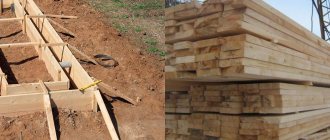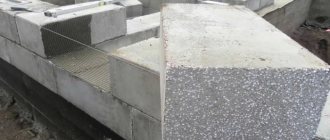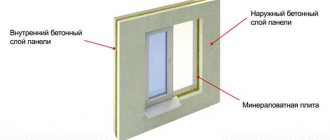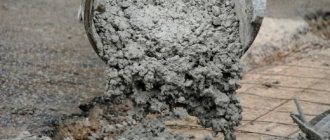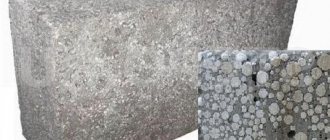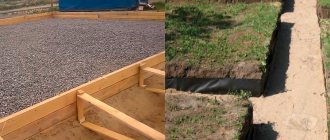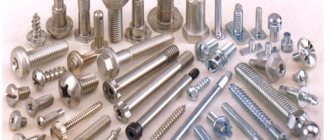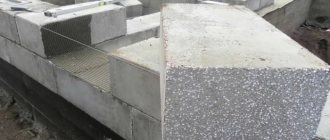This formwork structure is a set of necessary elements using magnets, with the help of which monolithic products are given the shapes required by the design specifications. Magnets for concrete formwork will help you set the system according to any geometric parameters.
Areas of use
Using magnetic formwork, you implement tasks of varying levels of complexity associated with the molding of flat reinforced concrete products, the maximum height of which reaches sixty centimeters.
It was possible to solve the problem of fixing embedded elements, void formers, chamfers and rustications.
Heavy and fine-grained concrete grades are used for pouring airfield and road slabs, bridge structures, monolithic supporting elements and spans. Reinforced concrete sleepers, support poles for power lines, and pipes for water drainage are made from them.
Types and sizes of concrete rings for wells
Industrially manufactured concrete and reinforced concrete rings must meet the standards prescribed in GOST 8020-90. Their dimensions can be taken from the table, as well as the approximate weight and price (indicated including delivery in Moscow).
To manufacture products of each type, there must be two parts of the formwork - external and internal. The distance between them is specified in GOST and depends on the size of the ring. For reinforced rings for a well with a diameter of 70 cm or 100 cm, this is 7 cm and 8 cm, respectively; when making rings without laying reinforcement, the wall thickness is much greater - 12 cm and 14 cm.
For the manufacture of reinforced concrete rings, special molds are required
In addition to different sizes, there is also a different profile of the end part of the rings - smooth and with a lock. A lock is a tongue-and-groove protrusion. Such rings are called tongue-and-groove or locking rings. When placed on top of each other, they adhere well and are difficult to move under lateral loads, which is very important when constructing wells for any purpose. The disadvantage of this option is that the shapes for concrete rings are more complex - it is necessary to form appropriate steps at the ends.
Advantages and disadvantages
Magnetic formwork fastenings have a number of advantages over conventional systems:
- the use of magnetic formwork for the manufacture of reinforced concrete products can reduce the time required for installation to seventy percent;
- The formwork structure is compact, light weight, and ergonomic. In addition, builders note the environmental friendliness of the equipment, which leaves a minimal amount of waste;
- production of the formwork form and its further maintenance does not require special skills from the performer;
- additional work requiring energy costs and the use of mechanical means is completely eliminated;
- formwork forms are easily fixed and allow products to be poured with a high level of accuracy;
- magnetic formwork for the production of precast concrete products is a durable structure. In addition, it has the flexibility to reconfigure elements to produce designed products with specific configurations;
- the presence of a large number of adapters makes the equipment multifunctional;
- from a long operational period, if all requirements are met, the structural elements do not change their characteristics;
- magnetic blocks are completely waterproofed and can operate at any temperature;
- It is even possible to produce a radial configuration for individual orders.
Board equipment for reinforced concrete products: Industrial construction
Rotary tables
Metal molds for precast concrete products are designed for the production of panels of various thicknesses and lengths for the construction of industrial, civil and commercial buildings and structures. In particular, turntables for industrial panels usually have one fixed side and one folding side.
The size of the panels depends on the type of separators used, such as magnetic separators. In addition, rotary tables are equipped with electric or pneumatic vibrators, which ensure high-quality compaction of concrete. If necessary, they can be equipped with heating pipelines to speed up the curing of concrete products
Stationary tables
Form equipment for the production of prefabricated monolithic floors, foundation slabs and low-span floor slabs. The dimensions of each type of product are determined by the needs of the Customer. In addition, rotary tables are equipped with vibration motors, usually pneumatic.
Forms for beams and stands for prestressed elements
This equipment consists of universal adjustable stands, anchor stops and beam side equipment.
- Reconfigurable stands . Metal molds with a set of drilled holes for the production of products of various widths.
- Prestressing equipment and anchor stops . The design of the anchor stops assumes the active and passive sides of the technological stand for the manufacture of prestressed elements. The design of the stops varies depending on the required tension force.
- Side equipment of beams . These shapes are used to produce beam segments and beam elements to produce structures of varying heights and widths.
Self-supporting molds for TT slabs
Forms for precast concrete elements used in the construction of industrial and commercial buildings. The self-supporting mold for TT slabs is equipped with electric or pneumatic vibrators, as well as a heating system.
Forms for columns
- A simple form for columns with mechanical (manual) control . The mold is designed for the production of reinforced columns.
- Hydraulically controlled column mold . A mold for the simultaneous production of two reinforced beams, each of which can have a different thickness.
- Universal form for columns . The mold is designed to produce columns with cantilevers on all four sides at different heights.
Design features
Magnetic locking elements are represented by magnetic blocks located in a housing made of steel material and moving vertically in it.
When the magnetic block is in the lowered position, the locking element is firmly attached to the metal base. To lift the magnetic block, use a special eccentric-type puller or other lever. The retaining housing has a pair of threaded holes that make it possible to connect to the on-board systems adapter. Such an adapter is capable of functioning at temperatures ranging from fifty degrees below zero to one hundred degrees above zero.
Structurally, the locking magnetic element consists of a block, a device for installation and an adapter element. The technological process of manufacturing reinforced concrete structures with magnetic fixation included metal pallets, fixing magnets, sides (made of metal, wood, plywood sheet or plastic material).
Pallets are marked according to the parameters of future products, the sides are set, pressing them with magnetic fixing elements. The reinforcement frame is laid and the concrete solution is poured. As soon as the concrete reaches a sufficient level of strength, the clamps are removed and the product is moved using lifting equipment.
To install the latch, hook it to the side and push the lever down so that the magnetized block is firmly pulled to the pallet. The lock is simply removed - the lever is moved in the opposite direction.
Magnetic formwork for concrete products is fixed firmly and quickly; welding is not used, which eliminates the need to clean tables.
The technology is in demand in small-scale production processes, when the preparation of special casting molds is not economically feasible.
Void formers
These include:
- plates - designed for the manufacture of holes for embedded elements. They are made according to specific shapes from steel, equipped with a built-in magnetic system and a removable device. Plates are often used for vertical and horizontal molding; their thickness starts from one centimeter. Any configurations, up to custom manufacturing;
- chamfer and groove formers - such devices are structurally no different from plates, they are also similar in application. Elements for forming grooves can be made up to fifty centimeters in length;
- loop formers and inserts are three-dimensional metal products equipped with built-in magnetic systems. Dismantling is carried out using special pullers included in the formwork kit. Inserts can be made in the shape of ovals, pyramids or cones.
Magnetic board
The use of such an element is considered appropriate if serial production of reinforced concrete structures is planned.
Boards can be developed in several types:
- with internal fixing blocks;
- with external blocks for fixation.
The dimensions of the sides are as follows:
- in length - from one to three meters;
- in height - from ten to forty centimeters.
Each side is equipped with connecting elements that allow you to increase the length of the forms taking into account the wishes of the buyer.
Board equipment for reinforced concrete products: Infrastructure facilities
Forms for tray elements and box drainage systems
- Molds for articulated large-sized trays . Forming equipment for the production of articulated large-sized tray-type elements allows you to simultaneously produce a large number of finished products.
- Modular forms of vibration-free casting of box-shaped drainage systems . Mold for the manufacture of box-type drainage systems. This equipment allows the production of elements of various standard sizes.
- Installation MT20 for vibrocompression . This forming equipment is used to produce about ten units of box-shaped drainage systems per day.
Special volumetric forms
- Uniform for prison cells . This form, as its name already suggests, is used to make concrete prison cells. Finished products have a high degree of smoothness on the front and inner surfaces and may include various elements, such as windows and doors.
- Forms for power transformer substations . Equipment for reinforced concrete structures for the construction of power electrical substations.
Forms for mainline and railway transport construction
- Forms for New Jersey blocks and parapets . The shape for the production of New Jersey blocks, design features and dimensions are consistent with the needs of the Customer.
- L-shaped highway retaining wall . L-shaped retaining walls are made in a similar way to rotary tables.
- Forms for cable trays on rotary installations . Molds for the production of reinforced concrete cable trays for the arrangement of highly reliable engineering communications during the construction of railway infrastructure facilities.
- Metal mold for bridge construction elements . The mold for the manufacture of longitudinal elements of bridge construction can be equipped with a pneumatic vibration unit.
Forms for containers, storage facilities and other infrastructure facilities
- Form for underground containers . This metal mold is intended for the production of underground containers; it is equipped with hydraulic cylinders to optimize the demoulding of the finished product.
- Forms for stream mouths . Molds are used in the production of concrete mouths of watercourses and canals.
- Form for inspection wells . This form allows the production of any type of manholes for servicing sewer networks and utility lines.
- Forms for niches . Equipment for reinforced concrete structures for the construction of columbar walls.
Calculation of the number of magnets
When deciding to use magnetic clamps on a universal formwork structure, it is recommended to consider:
- the importance of the design strength and mechanical stability of the entire system;
- measures that protect magnets from corrosive formations, especially neodymium ones, which can be destroyed by rust, thereby causing catastrophic consequences;
- quality condition and uniformity of the material used as a magnetic core;
- the correct air temperature, which can reduce the magnetic capabilities of the cores;
- conditions affecting magnetic adhesion and support using formwork surface release agent;
- magnet adhesion, selected taking into account the thickness of the formwork metal and load effects.
If there is a simultaneous impact from two negative factors, the adhesion of the magnet is lost partially or completely.
To determine the number of magnets, you should know the length and height of the formwork structure and the adhesion force of the magnet. In addition, the dynamic load effects on the formwork that occur during pouring of concrete mortar and its subsequent compaction are taken into account. To make it easier to determine the required number of magnets, you can use special tables for pouring various concrete solutions approved by GOSTs.
What are concrete rings for?
Most often, concrete rings are needed to construct a well, but they are also used to construct an autonomous sewer system - to make septic tanks or filtration wells. Another area of application is inspection wells when installing stormwater and drainage systems. Even cellars are made from concrete rings. Moreover, there are different options - vertical, horizontal. In general, the scope of application is wide.
Concrete rings are used for the construction of various structures
There are rings of different sizes to suit different needs, they also have different wall thicknesses, and can be with or without reinforcement. Despite such an abundance of choice, many people think about making reinforced concrete rings with their own hands. The thing is that when arranging a site you may need more than one ring, or even ten. Some people spend more than a dozen just on a well. The cost of manufacturing reinforced concrete products is much lower than their retail price. Even taking into account the fact that you will have to make molds for concrete rings. And if you also take into account the cost of delivery, the savings turn out to be very significant.
Formwork for well reinforced concrete rings
Most structures for domestic autonomous sewerage are installed using reinforced concrete well rings. These structural elements are highly durable and can withstand significant loads arising from soil movements. The only relative disadvantage is the cost, which cannot be called low. That is why formwork for rings is becoming increasingly popular, allowing you to pour them yourself at home.
Formwork for well rings
